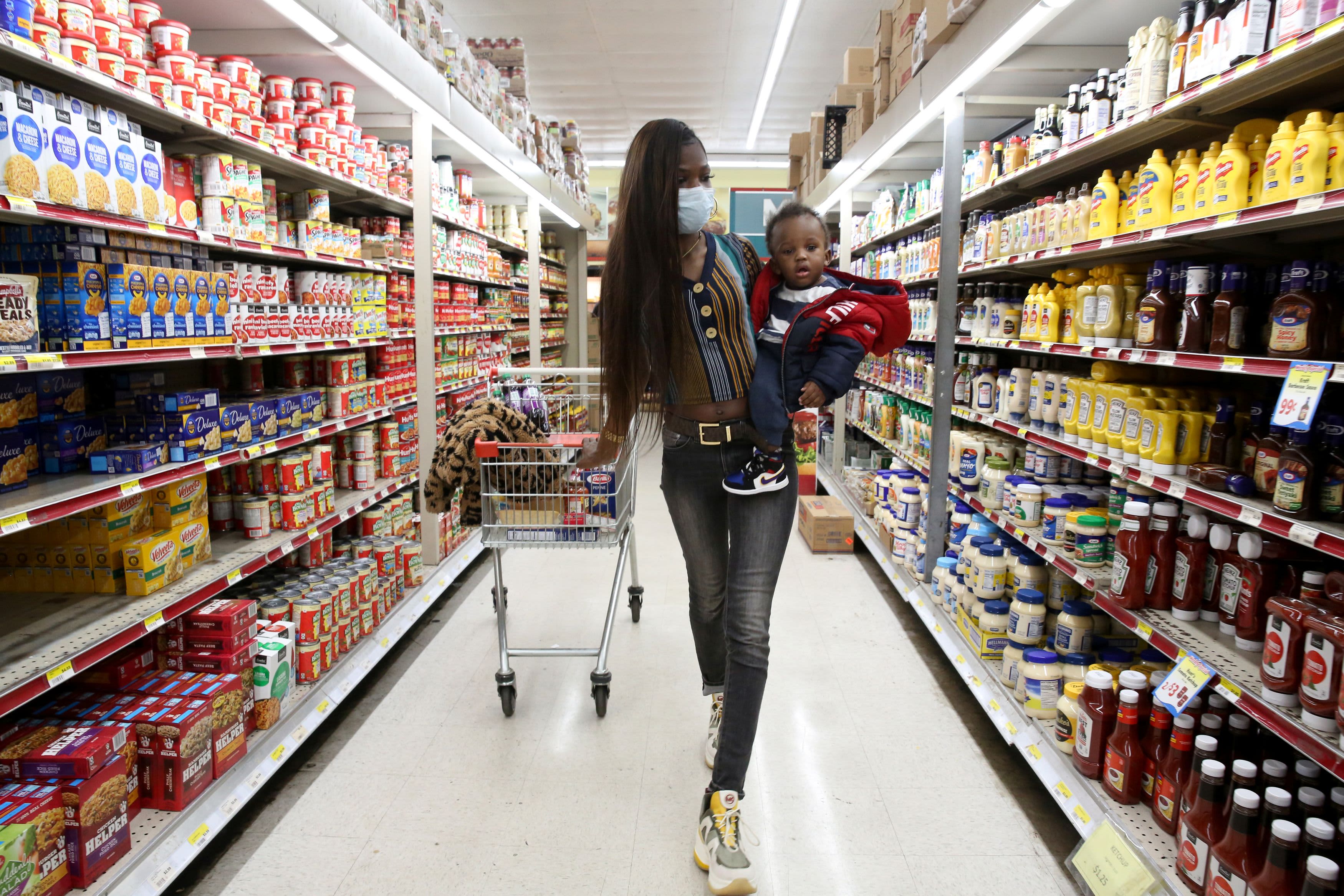Mic’Kale Smith, who works as a security guard but has had to take time off to care for her son during the coronavirus disease (COVID-19) outbreak, wears a face mask as she shops with her son Da’Mier at the Tiger Market in Oxon Hill, Maryland, May 20, 2020.
Jonathan Ernst | Reuters
Consumer prices excluding food and energy rose the most in one month in nearly 30 years in July, but the unexpected increase is seen more as a recovery from the Covid-19 recessionary hit rather than the start of an inflationary spiral.
Core inflation, less food and energy, was up 0.6%, and is now running at a 1.6% rate year over year on an unadjusted basis, according to the Bureau of Labor Statistics. That’s the biggest jump since January 1991, but it is still considered to be a low rate and it is below the Fed’s 2% target.
Headline CPI also increased 0.6% on a seasonally adjusted basis in July, twice as much as expected. Year-over-year, the Cosnumer Price Index was up 1% on an unadjusted basis, compared to expectations for just a 0.7% hike.
“I don’t think it’s a worry. It’s not going got be on the Fed’s radar screen. They’re just going to take it as an offset of the months of declines. We fell exactly 0.6% over March, April and May,” said Chris Rupkey, chief financial economist at MUFG Union Bank.
Some investors have been expecting the Fed’s easy money programs and high federal deficits to spur a wave of inflation by next year. Chairman Jerome Powell said after thelast meeting that the Fed was more wary of disinflationary pressures.
“Prices are coming back. We’re back to square one,” said Rupkey. “We’re back to seeing where the true trend lies. I don’t think that’s stoking the fires of inflation … The Fed’s opened the spigot here. We’re doing money printing. I would not take this as a sign inflation is back and the inflation genie has escaped its bottle.”
A 5.6% increase in gasoline prices accounted for about a quarter of the jump in headline inflation, while food prices actually declined by 0.4%, the first drop since April 2019. Gasoline is down 20% year-over-year, while food prices are up 4.1% on the year.
Stocks shrugged off the higher inflation reading and moved higher.
Quincy Krosby, chief market strategist at Prudential Financial, said the jump in inflation is a one-month move and not a concern to the market unless it becomes persistent. “You want to see a healthy climb in prices again. It suggests economic activity is picking up. But you don’t want to see a galloping move in prices,” she said.
The dollar moved slightly lower against its global peers, as the U.S. currency slipped against the euro after the data. Spot gold prices rose slightly. Treasury yields were mostly steady, with the 10-year note at 0.67% ahead of a 1 p.m. ET auction.
‘Healing of the economy’
“The fact we saw an increase in inflation make up for weakness from earlier this year is evidence of further healing of the economy,” said Jon Hill, senior fixed income strategist at BMO. “Eventually this will give way to a slow recovery with a likely return to low inflation. We’re going to see volatility in the month-to-month numbers as things get back on track. It’s serving as a reminder the price pressures are stabilizing. We’re going to avoid a deflationary trap.”
In the market for Treasury Inflation-Protected Securities, 5-year breakevens were 6.5 basis points higher, reaching 157 basis points, the highest since Feb. 24. That means the Treasury market is pricing about a 1.6% average inflation rate over the next five years.
“That’s still below 2%, the Fed’s target,” Hill said.
But Peter Boockvar, chief investment strategist at Bleakley Advisory Group, said the data shows inflation may already be here and that could be evident in the higher than expected producer price index and CPI.
The stock market has been boosted by the idea that the Fed will not need to raise rates for a long time to cover, so rising inflation would change that outlook.
“If this continues, it will be the Fed’s worst nightmare no matter how many times they say they want higher inflation. Treasury yields are at the highs of the day and while stocks don’t’ seem to care, the inflated areas of the market should,” Boockvar said in a note.
“Own commodity related names, banks and any company that has pricing power … The world’s level of asset prices have feasted on many years of ever lower rates and low inflation,” he added. “Just think about the possibility of that regime changing and invest accordingly. Sorry for the hyperbole but we should all be always assessing the state of things and looking for possible inflection points. Maybe, just maybe, this is one of them.”
In the CPI, the cost of some services jumped sharply. Motor vehicle insurance was up 9.3% in July, on top of a 5.1% increase in June. Wireless telephone services rose 3.6%.
Goods also rose. Prices for used cars and trucks climbed 2.3%, while new car prices increased 0.8%.
Airline fares also rose, up 5.4% in july, on top of a 2.6% jump in June. Shelter costs rose 0.2%, or 2.3% year over year.
The cost of food at home fell 1.1%, after rising 0.7% in June. Food away from home also rose 0.5% in both June and July, as restaurants reopened and consumers could have more meals outside of their homes.
The government said the cost of food at home index rose 4.6% over the last 12 months, with gains in six major grocery store food groups. Beef was up 14.2% , while fruits and vegetables were up 2.3% over the 12 months.
